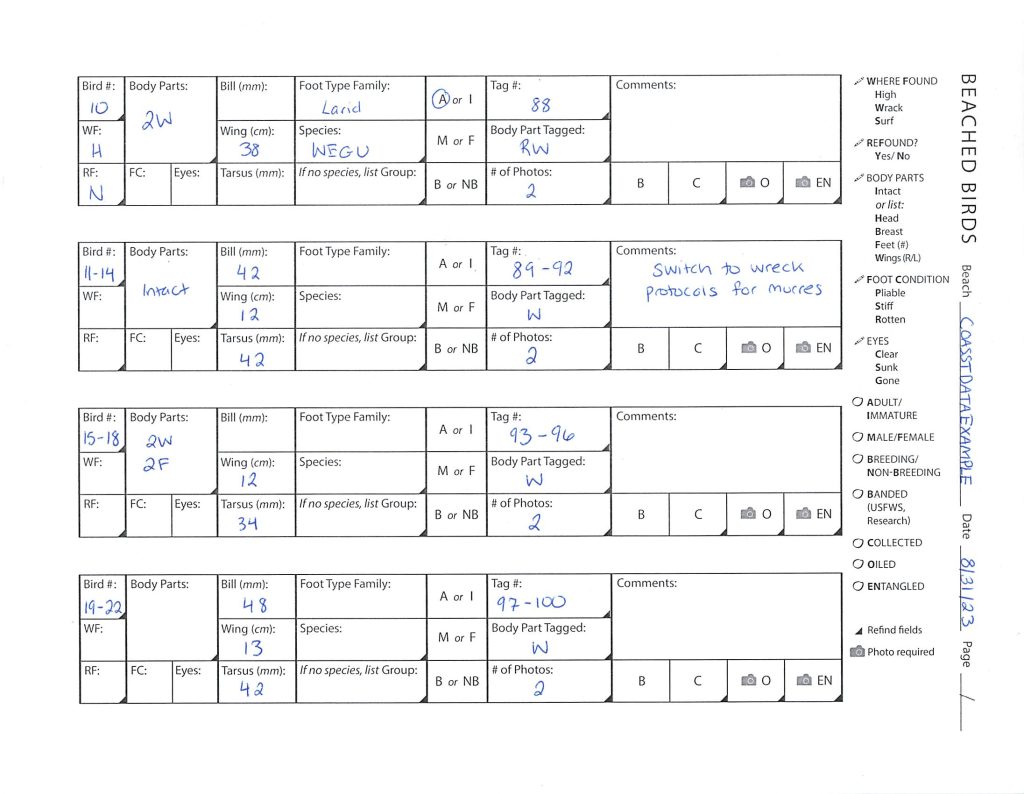The number of birds found on each COASST survey varies month-to-month and year-to-year, even on the same COASST beach. Over the last few decades of monitoring work, COASST has been able to establish an average, or ‘baseline‘, number of birds that we expect at different times of year, and in different geographic regions. (You can check out your region’s baseline in our Explore Data App!) COASST has identified some regions where birds are less likely to be found (like the inside waters of Puget Sound) and some where birds are reported on almost every survey (like the Oregon coastline).
What’s a wreck?
A few times each year, surveyors in bird-y regions might see as many as 40 or 50 beached birds on a single survey. These ‘wrecks’ are small-scale mortality events where many birds of the same species wash up on beaches due to a cyclical change like stormy seas in the winter, or breeding season fatigue mid-summer. And they aren’t always a cause for concern; this blog post describes our regular Common Murre wreck, which is generally a sign of a good breeding season on the murre colonies!
What should COASSTers do with a beach full of birds?
Even when wrecks are a sign of successful breeding or natural cycles of mortality, they always mean more time on the beach for COASST surveyors. But we don’t want surveyors walking beaches late into the evening just to get that last bird recorded!
In the video below (a webinar recorded in 2021) we covered our best tips for surveying during a wreck – shortcuts that will save you time while preserving the best data possible at a critical moment on the beach. You can watch the first 24 minutes for an overview of mortality events including wrecks – with insights from our chief bird verifier Charlie Wright – or jump to minute 24 to hear our recommendations for survey modifications. The webinar ends with a discussion of MME’s (or mass mortality events) and the additional streamlined procedures you can implement if faced with hundreds of birds on a single survey.
A quick summary of our suggestions for wrecks:
You can review pages 4BB 56 – 4BB 59 in your protocol binder for more suggestions and information.
Plan ahead: If you know that it’s a ‘wreck’ time of year in your region, you might plan to bring an additional helper on your survey. Extra data sheets, snacks, gloves and hand sanitizer are a great idea!
You should also make sure you have a full set of tags on hand. Email us at coasst@uw.edu for a resupply anytime
Photographs: In a wreck situation PHOTOS ARE KING!
Normally 2 photos are required per carcass, but during a wreck you should group birds for speed. We still ask for two great photos (displaying the birds from the back and the belly) but that’s for every 4-bird grouping. If you’d like a refresher on how to take a great photograph, you can check out this blog post. Below are two wonderful examples of birds photographed during a wreck (left) and mass mortality event (right).


Species Identification: Instead of using your guide to record an identity for each bird, sort by ‘look-alike’ birds (in the same species and state of intactness) and just take photographs in groups of 4. Our office team will handle the identification.
Measurements: On a normal survey, COASSTers measure every bird. In a wreck event we suggest measuring the first 10, and then just one per photo that you submit. (If there’s time! If not, remember that great photos will make up for any other lacking data!)
Freshness: Similar to measurements, you should record freshness characteristics only on the first 10 of each species on your survey during a wreck. After that, leave it to the photo reviewers.
Plumage variation: Age, breeding, and sex identification fields can all be left blank during a wreck. Our survey team will fill in those details if possible, by reviewing photos.
Tagging: Mark birds using wooden tags as usual, unless extremely time constrained (see Mass Mortality Event protocols in your white binder). If you run out of tags, simply tie a piece of tag-less twine on the carcass to make sure you don’t double-count next survey.
Here’s how your datasheet might look during a wreck survey:

Good luck on your wreck surveys, and please let us know if you have any questions or suggestions. We’d love to share time-saving techniques from experienced COASSTers!
